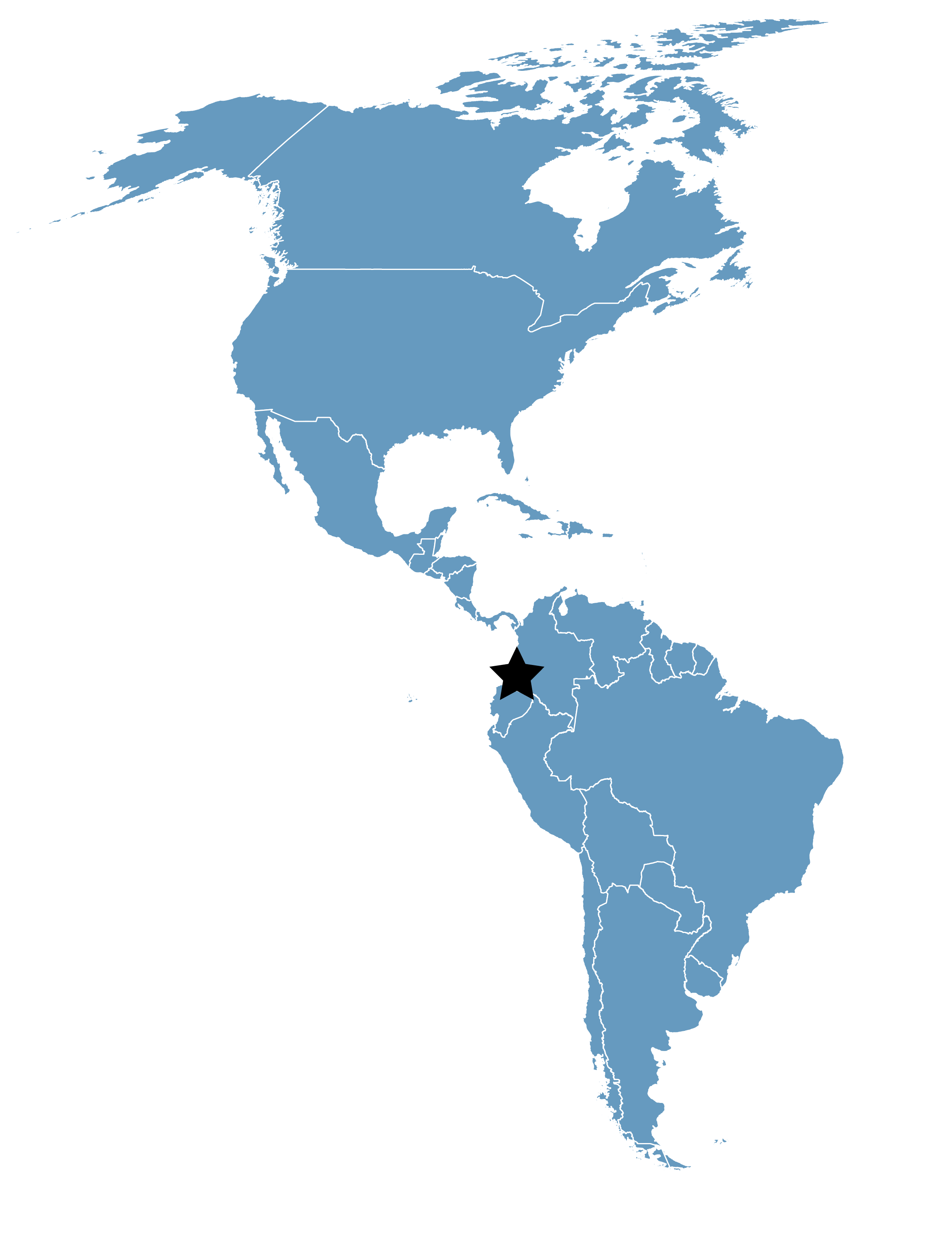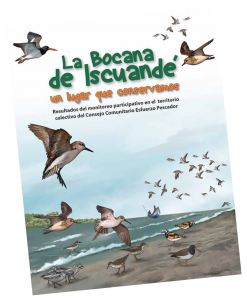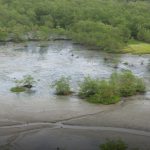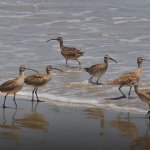Delta del Río Iscuandé
Location
Santa Bárbara de Iscuandé, Nariño, Colombia
Category
Regional
Basis for Designation
Some 50,000 shorebirds migrate through this site annually, including 18% of the global population of Wilson’s Plover (Charadrius wilsonia) and more than 1% of the hemispheric population of Spotted Sandpiper (Actitis macularius).
Size
4,000 hectares (9,884 acres)
Date Designated
February 2009
Site Owner
Municipality of Santa Bárbara de Iscuandé. According to Law 2324 (established in 1984), the site is a lowtide zone; the title is non-transferable but others can obtain concessions, permits, or licenses for uses within the zone that conform to the Law.
Site Partners
Esfuerzo Pescador Community Council
Municipality of Santa Bárbara de Iscuandé, Department of Nariño.
Overview
The Delta of the Iscuandé River is located in the northwestern Pacific coast of Colombia, Nariño Department, on the border with the Cauca Department. Several islands that formed through the siltation process of the Iscuandé River constitute the area. Coastal environments such as sandy beaches, muddy plains, and mangroves are representative of the area. Most of these ecosystems are important for waterbirds, especially seabirds and shorebirds that use them as resting and breeding grounds. The Delta of the Iscuandé River is part of the Sanquianga National Park buffer zone, which has an extension of 89,000 hectares (219,750 acres), and is a protected area managed by the government of Colombia. The park maintains the best preserved mangroves in this area of the Pacific coast. The climate in the whole region is tropical humid and precipitation reaches 7,000 millimeters per year.
The site holds 18% of the continental population of Wilson’s Plover (Charadrius wilsonia) and 1% of the hemispheric population of Spotted Sandpiper (Actitis macularius).
Shorebirds and Other Wildlife
The site holds 18% of the continental population of Wilson’s Plover (Charadrius wilsonia) and 1% of the hemispheric population of Spotted Sandpiper (Actitis macularius). Delta del Río Iscuandé is also mentioned as an important site in the Whimbrel (Numenius phaeopus) Species Conservation Plan. It is estimated that this site is used annually by about 50,000 shorebirds.
The Delta is strongly influenced by the Pacific Ocean tidal regime; the difference between high and low tide is 4.3 meters. The siltation process generated by the Iscuandé River has produced several sandy-muddy islands that have consolidated through time and are used by birds. The area is made up of several coastal ecosystems, such as sandy beaches, muddy plains, and mangroves. Most of these ecosystems are important for waterbirds, especially seabirds and shorebirds that use them as resting and breeding grounds.
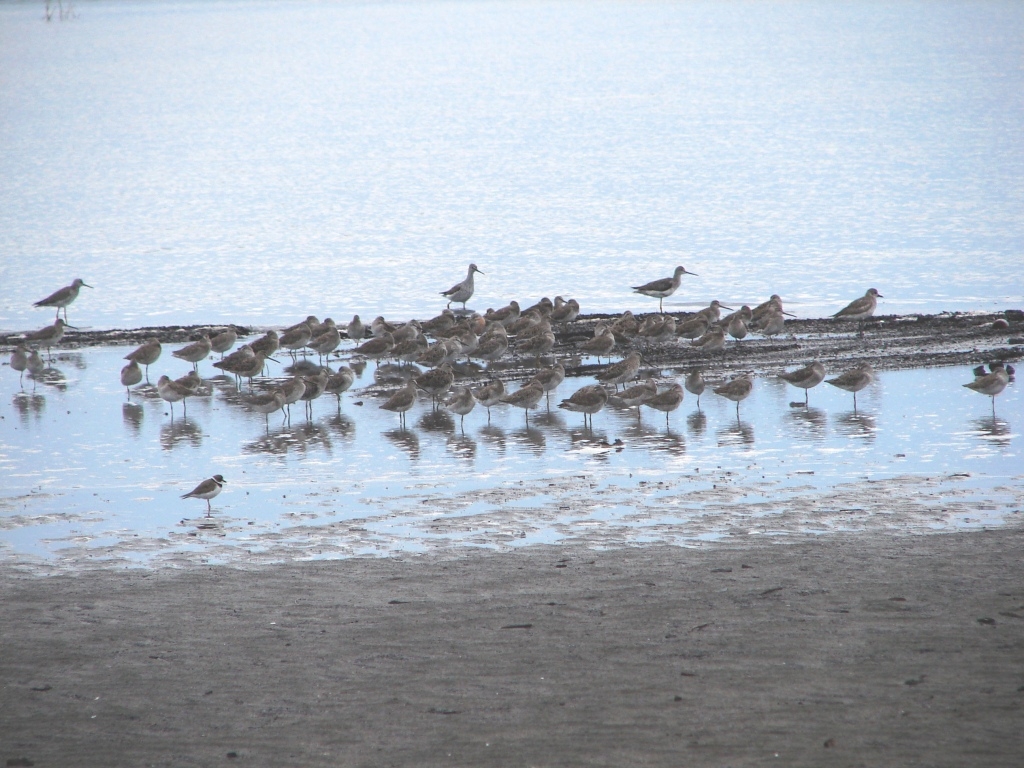
Flock of shorebirds resting on the beach. Photo: Asociación Calidris.
The area is a resting and feeding site for seabirds such as Pelecanus occidentalis, Sula nebouxii, Sula leucogaster, Phalacrocorax brasilianus, Thalasseus maxima, Leucaphaeus atricilla,and Leucophaeus pipixcan. A breeding colony of P. brasilianus is located in the Bocana Iscuandé area. The zone also provides breeding grounds for the shorebirds Charadrius wilsonia beldingi and Haematopus palliatus. The herons Nyctanassa violacea and Nycticorax nycticorax are present but there is not evidence of reproduction yet. High concentration of egrets and herons is very common: Egretta thula, Ardea alba, Ardea cocoi, Egretta tricolor, Egretta caerulea. Egretta rufescens and Ardea herodias are sporadically present in smaller numbers. Furthermore, approximately 150 pairs of Gelochelidon nilotica breed in the area, constituting the largest documented reproductive colony of this species in Colombia. There is also the presence of other migratory birds, such as Anas discors, Seiurus noveboracensis, Contopus sp. and Doliconix oriziborus. Land birds associated with the surrounded vegetation are Quiscalus mexicanus, Amazilia tzacatl, Tyrannus melancholicus, Dendroica petechia, Coccizus melacorryphus, Crotophaga ani, Hirundo rustica, Laterallus sp.
Other fauna that has not received research attention yet are the reptiles and amphibians Basiliscus galeritus, Bufo marinus, Boa constrictor, Iguana iguana, Bradypus sp.,and Noctilius sp. This site is also used by the endangered sea turtle “Caguama” (Lepydochelis olivaceos) as a nesting area.
Local Community
There are nine communities comprising approximately 1,000 people within the Iscuandé River delta. Fishing along the river and collecting mollusks from the mangroves are essential for their subsistence and to the local economy. In a capacity-building workshop coordinated in 2009 by the bird conservation organization Asociación Calidris, the community members identified a lack of basic sanitation as one of the gravest threat to their resources and, in turn, their way of life. The communities made it a priority in the short term to find sanitation solutions that would improve their quality of life and also benefit shorebirds and the delta’s biodiversity. With a grant from the Wetlands for the Future Fund (facilitated by the Ramsar Secretariat, U.S. State Department, and U.S. Fish and Wildlife Service), Asociación Calidris worked with fishermen, housewives, teachers, and community leaders to gather baseline diagnostic information on sanitation issues. They also developed educational outreach materials to raise awareness about what individuals could do to help resolve community-wide problems.
Project leaders and communities are now seeing the fruits of their hard work. Environmental conditions and residents’ quality of life within the WHSRN site are improving, and the connection between the two is more tangible than it was when the site was first designated. Their efforts continue, with goals for building local capacity to implement more technical water treatment solutions and solid waste management.
Threats
There are two major threats to the site. One is related to solid waste disposal, which is carried to the area by the river and accumulates on the beaches. The human population growth “upstream” and the absence of a proper waste disposal system have lead to this pollution because all the wastes are thrown into the river and then carried to the sea. The other major threat is the increase of sediments being deposited during low tide as a result of upstream deforestation, caused by different extractive human activities.
Disturbance is mainly caused by urban expansion and changing consumption habits among populations living in the main city near the area. Increasing populations add to the problem of an inadequate waste collection and disposal system, causing increased accumulation of solid waste on the delta beaches. This problem also affects the breeding colonies of Ch. wilsonia, which are running out of available space for nesting. The increased presence of dogs and cats in La Cunita and Quiñónez areas are also a source of disturbance for birds using habitat near some settlements (Juanchillo y Ensenada).
Furthermore, land conversion along river banks for agricultural purposes has increased the quantity of sediments that are deposited in the low tide zone. Another aspect is the collection of bird eggs by local people to supplement their diet, in addition to capturing chicks as pets.
The development of a waste management system and a sanitation plan is critical for the closest communities to the site (Juanchillo y Ensenada), which together have a population of 500 people approximately. Another important area of work is to influence the municipal planning so the Land-use Zoning Plan considers this area as a Conservation Area and regulates any urban development plan.
Asociación Calidris has been working in the area since 2004, where it conducts regular seabird and shorebird censuses as well as shorebird banding. They have also carried out studies on the trophic ecology and reproductive monitoring of Gelochelidon nilotica and Charadrius wilsonia.
Resources
This beautiful illustrated report by Asociación Calidris explains the results of three interwoven citizen science projects in the Delta del Río Iscuandé.




